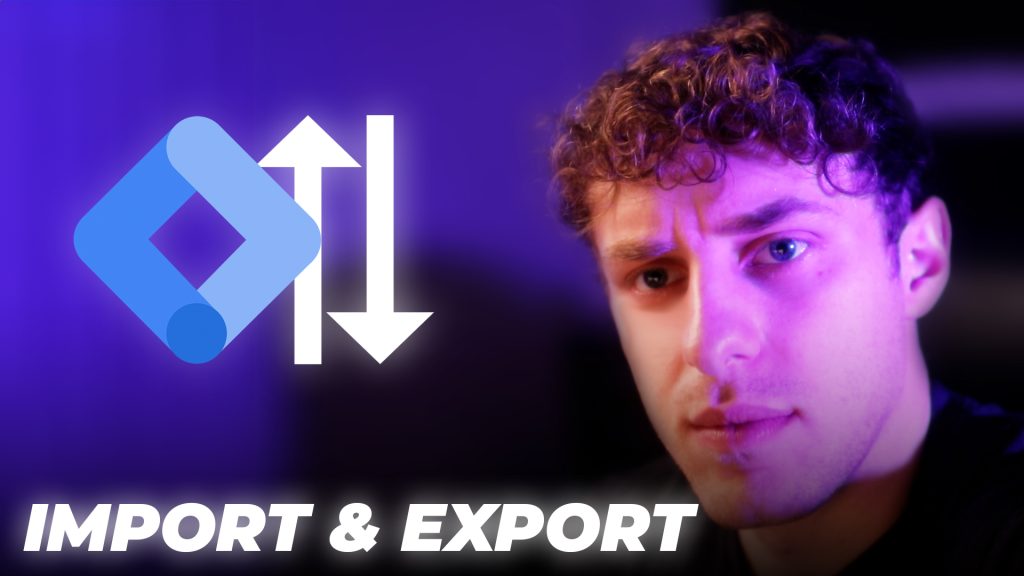
It’s both safe and easy to copy Google Tag Manager tags into other containers.
Let’s say you have five clients, and a list of events you want to track for each of them.
Their websites are all different. They all operate in different industries. They all have their own Google Tag Manager containers.
You only need to make these tags one time. Not five.
Here are a few examples of tags that can be set up in one container and work across all of your clients’ site:
- Form submissions
- Scroll depth events (how far an user goes down a page)
- Ecommerce activities – purchases, add to carts, item views
- Email address clicks
- Outbound link clicks
- Page views
- Advertising platform pixel tags (just need to change pixel ID)
Don’t start over every time you get a new client.
Use the Export/Import Container Feature in Google Tag Manager
Google Tag Manager has a built-in function that allows you to export all of your tags, triggers and variables from one container, and import them into another container. Let’s go through this process.
1. Set up the tags, triggers and variables you want to use in one container.
- Pick one of your client’s containers, and start setting up the events you want to track.
- Here’s an example of a tag/trigger that tracks when users click on an email address. It works in all containers.
3. Here’s a form submission tag/trigger that can track all form submissions on a site. Just note, many sites have custom form submission integrations, so don’t use this as a catch-all for forms.
4. Last example, an ecommerce tag/trigger that is essential for any business selling products. This tag/trigger tracks when an user views a product, adds it to their cart, or purchases it.
5. Please do your research into basic tags/triggers when setting these up. Copying these screenshots isn’t a guarantee that those tags will work on all of your sites.
2. Export the Google Tag Manager Container.
- Once you’ve finished setting up your first container, you’re 95% of the way done.
- In this same container, navigate to Admin (top left).
- In the container section, click Export Container.
- Under Workspaces, select the Workspace you created your tags, triggers and variables in.
- A list of all the items in the workspace will appear. Make sure all of the tags, triggers, and variables you used are selected. Deselect any you do not want to use in your other containers.
- Click Export. The .json file containing all of your work should download to your computer.
3. Import this .json file into your other container(s).
- Navigate to your next client’s Google Tag Manager container.
- Go to Admin.
- In the container section, select Import Container.
- Click Choose container file.
- Upload the .json file you just exported from your other container.
- Choose a New workspace. This is a better choice if this client already has a workspace and some tags set up.
- Merge the new container. Rename conflicting tags, triggers and variables. This makes sure nothing already in the container gets overwritten when you finish the import.
- Confirm the changes. This will finish the import.
4. Check your container.
- Look at your container’s new workspace and make sure it has all of the tags, triggers and variables you imported.
- Make changes to any website/platform-specific ID’s. For example, each website with a GA4 property has its own measurement ID, so you need to change your GA4 event tags to send to the correct property. Otherwise, you will start sending data from multiple containers to your first client’s GA4 property.
- Run a test session. Use Google Tag Manager’s Tag Assistant feature to go test out all of your imported tags and make sure they work.
5. Repeat and publish your containers.
- Upload that same .json file to any other containers you want to store those tags in.
- Publish your containers. None of these newly built tags will send data to GA4 or your ad platforms until you’ve published the Google Tag Manager container.
- Hit Submit in the top right corner of your container’s workspaces. Name your versions and give short descriptions in case of future version control.
6. Monitor your containers as data starts to flow in.
- Sadly, problems almost always occur when first setting up Google Tag Manager.
- Check back on your client’s GA4 / ads properties to make sure they’re getting the right event data.
Summary
This is the easiest way to copy Google Tag Manager tags into other containers. It will save you time, budget, and errors.
If you’re still having trouble and need more help, book a short call with us. We can take a look at your setup with you and try to help.